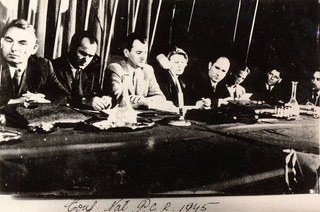
Romania competed at the 1980 Summer Olympics in Moscow, USSR. 228 competitors, 154 men and 74 women, took part in 135 events in 20 sports.

Doina, or Doină, is a political poem by the Romanian Mihai Eminescu. It was first published in 1883 and is therefore seen by some as Eminescu's final work in verse, although it may actually be an 1870s piece, inspired or enhanced by the perceived injustice of the Berlin Treaty. A variation of the doina, picked up from Romanian folklore, it is noticeably angry to the point of rhetorical violence, a radical expression of Romanian nationalism against invading "foreigners", with additional hints of ecopoetry and "anti-technicist" discourse. Doina delineates the ideal geographical space of Greater Romania, at a time when Romanian-inhabited regions were divided between an independent kingdom and multinational empires. Its final lines call on Stephen the Great, depicted as a sleeping hero, to take up the cause of Romanians and chase foreigners out with the sound of his horn. The same basic themes appear in another poem by Eminescu, the anthem-like La arme, which is sometimes discussed as a variant of Doina.

Events from the year 1945 in Romania. The year saw the end of Romania's involvement in World War II and the foundation of the pro-Communist government of Petru Groza.
Events from the year 1944 in Romania. The year was dominated by the Second World War. The year started with the Soviet Army assault on Romanian troops and the Battle of Romania. King Michael led a coup d'état during the year and Romania left the Axis powers and joined the Allies. The Romanian army subsequently won victories against German and Hungarian troops.
Events from the year 1947 in Romania. The year saw the abdication of Michael I of Romania and foundation of the Romanian People's Republic.
Events from the year 1946 in Romania. The year started with the end of the royal strike and ended with the Romanian Communist Party win the first election following the introduction of women's suffrage.
Events from the year 1939 in Romania. The year saw the assassination of Armand Călinescu.
Events from the year 1953 in Romania. The year saw the death of Carol II.
Events from the year 1954 in Romania. The year was marked by the 1954 Romanian blizzard.
Events from the year 1935 in Romania. The year saw the foundation of the Romanian Academy of Sciences.

Events from the year 1957 in Romania. During the year, Romania hosted the first European competition for female artistic gymnastics. The country enacted laws to ban prostitution and slavery, and provide for abortion on demand. Notable deaths include the sculptor Constantin Brâncuși.
Events from the year 1932 in Romania. The year saw the birth of two future Woman Grandmasters, Maria Albuleț and Margareta Teodorescu.
Events from the year 1958 in Romania. The year saw the end of the Soviet occupation of Romania with the last Soviet troops leaving the country.
Events from the year 1931 in Romania. The year was dominated by the Great Depression.
Events from the year 1964 in Romania. The year saw increasing separation from Soviet influence.
Events from the year 1963 in Romania. The year saw the continued de-satellization of Communist Romania.
Events from the year 1929 in Romania. The year was dominated by the Great Depression. Romania won on the first Balkan Cup, held this year.
Events from the year 1921 in Romania. The year saw the formation of the Romanian Communist Party out of the Socialist Party and subsequent imprisonment of the Communist leadership.
Events from the year 1922 in Romania. The year saw the Dealul Spirii Trial and the crowning of King Ferdinand.




